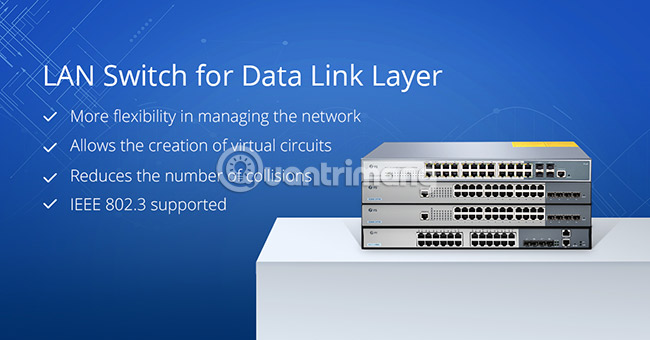How does the LAN switch (LAN switch) work?
With increased traffic and faster CPUs in computer systems, LAN (Local Area Network) is increasingly congested and overloaded. To reduce congestion and improve LAN speed, many IT technicians seek to use LAN switching technology and LAN switches to improve the performance of traditional Ethernet technologies, without having to perform upgrades. Costly or time consuming wiring systems reconfigure the server. So what is LAN switch and how does it route traffic using LAN switching technology? Today's article will give you the answer.
Learn about LAN switch
- Basics of LAN switching technology
- What is LAN switch?
- LAN switch uses 3 methods to route traffic
- Cut-through
- Store-and-forward
- Fragment-free
Basics of LAN switching technology
LAN switches are a form of switching in which data packets are transmitted from one computer to another via a LAN. LAN switching technology is very important for network design, because it allows traffic to be sent only to the required location. LAN switches mainly consist of 3 types of conversion methods: Layer 2 switching by MAC address based hardware, Layer 3 switching based on IP address and Layer 4 switching which can determine QoS (Quality of Service) for each user. Of these 3 methods, Layer 2 switching is most widely used for network segmentation in LANs. As illustrated below, the LAN switch is connected between the bridge and router to create 4 collision domains. It allows a flatter network design with more network segments than traditional networks (made up of repeater, hub and router).

A typical LAN consists of one or more LAN switches that can be connected to a router, modem or bridge to access the Internet. Other network devices such as firewalls, load balancers and network intrusion detectors can also be included in the LAN. Advanced LANs are characterized by the use of redundant links with LAN switches, using the Spanning Tree protocol to prevent loops, distribute QoS and separate traffic with Vlan.
What is LAN switch?
LAN switches are essential components used in LANs. The LAN switch is a network switch that connects two or more LANs and forwards packets between these networks. The maximum LAN switch speed is not more than Gigabit, usually at 1000 megabits per second. LAN switches use three types of LAN switches, namely Layer 2, Layer 3 and Layer 4 switches to route traffic in the LAN. Since most LAN switches operate at the Data Link layer (Layer 2), the Layer 2 switch is most commonly used and can be found in almost any LAN. It provides several benefits of both bridges and routers. Like bridges, LAN switches Layer 2 can forward traffic based on Layer 2 headers. Like routers, it partitiones the network into logical segments, providing management, security, and management of good multicast traffic. than. Switch Layer 3 or Layer 4 requires more advanced and expensive technology, so they are often used more in large LANs or in special network environments.

LAN switch uses 3 methods to route traffic
As mentioned above, LAN switches are based on packet switching. In the LAN network, LAN switch establishes a connection between two segments to send the current packet. Take the Layer 2 LAN switch as an example, incoming packets are saved to the temporary device in the server. The MAC address information is in the frame header for the source and destination of the packet to be read by the LAN switch and then compared to the list of addresses in the switch lookup table. Here are three methods that LAN switches use to route traffic in the Layer 2 conversion process.
Cut-through
In the Cut-through method, the LAN switch can read the MAC address as soon as it detects the packet. After storing 6 bytes of MAC address information, they immediately send the packet to the destination node, even if the rest of the packet is still being transmitted to the switch.
Store-and-forward
The Store-and-forward method stores all packets into the buffer and checks for errors before sending to the destination node. If the package has an error, it will be removed. Otherwise, the switch will look up the MAC address and send the packet to the destination node. Many LAN switches can combine these two methods, using Cut-through until a certain error level is reached and then changing to the Store-and-forward method.
Fragment-free
A less common method is Fragment-free. It works similar to the Cut-through method except to store the first 64 bytes of the packet before sending it. The reason is that most errors and conflicts occur in the first 64 bytes of the package.
LAN switches come with high scalability, security and ease of management. Currently, relatively low speed LAN switches are often used in ring network architecture and Daisy-Chain, due to the limited geographical scope of the LAN. For WAN environments, switch devices with higher speeds and capacities such as 10gbe switches, 40gbe switches and switch 100gbe will be essential.
See more:
- Basic knowledge of the network: Learn about the Router
- Learn about mesh routers
- How to secure IoT device properly
 How to secure IoT device properly
How to secure IoT device properly How to turn Raspberry Pi into travel router with VPN
How to turn Raspberry Pi into travel router with VPN Top 6 best 3G / 4G mobile WiFi transmitters
Top 6 best 3G / 4G mobile WiFi transmitters 7 best 802.11g wireless broadband routers
7 best 802.11g wireless broadband routers 10 commands to master when working with Cisco IOS
10 commands to master when working with Cisco IOS 4 tips to monitor and limit router traffic
4 tips to monitor and limit router traffic